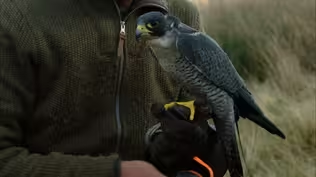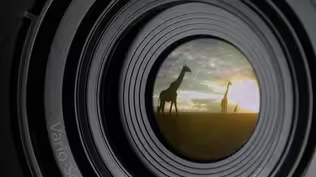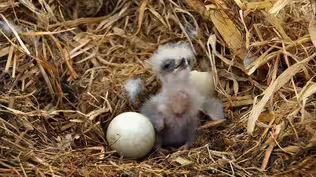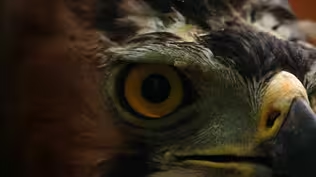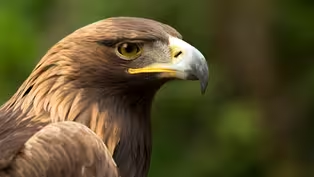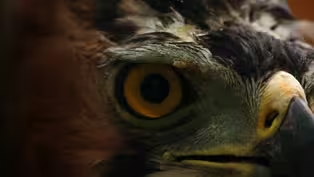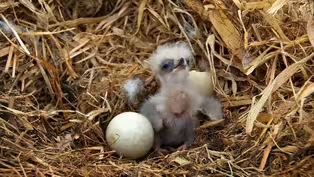
Eagle Power
Season 47 Episode 7 | 53m 21sVideo has Closed Captions
Follow eagles from the nest to the skies to see what makes these predators so remarkable.
Eagles dominate the skies. But what makes these predators so special? Researchers study one special bird—and stunning up-close footage reveals her exceptional strength, eyesight, and flying skills. With intimate access to a new bald eagle family, NOVA takes you into the nest to witness the drama of chicks struggling to survive.
Problems playing video? | Closed Captioning Feedback
Problems playing video? | Closed Captioning Feedback
National Corporate funding for NOVA is provided by Carlisle Companies and Viking Cruises. Major funding for NOVA is provided by the NOVA Science Trust, the Corporation for Public Broadcasting, and PBS viewers.

Eagle Power
Season 47 Episode 7 | 53m 21sVideo has Closed Captions
Eagles dominate the skies. But what makes these predators so special? Researchers study one special bird—and stunning up-close footage reveals her exceptional strength, eyesight, and flying skills. With intimate access to a new bald eagle family, NOVA takes you into the nest to witness the drama of chicks struggling to survive.
Problems playing video? | Closed Captioning Feedback
How to Watch NOVA
NOVA is available to stream on pbs.org and the free PBS App, available on iPhone, Apple TV, Android TV, Android smartphones, Amazon Fire TV, Amazon Fire Tablet, Roku, Samsung Smart TV, and Vizio.
Buy Now

NOVA Labs
NOVA Labs is a free digital platform that engages teens and lifelong learners in games and interactives that foster authentic scientific exploration. Participants take part in real-world investigations by visualizing, analyzing, and playing with the same data that scientists use.Providing Support for PBS.org
Learn Moreabout PBS online sponsorship♪ ♪ ♪ ♪ NARRATOR: High-flying... sharp-eyed... and deadly.
From mountaintops to river valleys, eagles rule the skies.
Strong enough to take down enormous quarry, they are the ultimate bird of prey.
(eagles cawing) By following a family of bald eagles...
This is our national symbol.
These are powerful birds.
NARRATOR: Witnessing eagles in action... JIM USHERWOOD: She's doing eight, nine, ten miles an hour-- up!
And that's fast.
NARRATOR: And by joining one man and his feathered friend, these icons of the air will be put to the test... (man cheering) What a girl!
That is actually very, very impressive.
NARRATOR: To reveal what it takes and even what it feels like... LLOYD BUCK: Wow.
We're flying with a golden eagle.
NARRATOR: ...to be the most powerful bird in the sky.
"Eagle Power."
Right now, on "NOVA."
♪ ♪ NARRATOR: It's late winter in Iowa.
(birds chirping) Under the most recent snowfall, this bald eagle is trying to protect her most precious possessions.
These two eggs must be kept at around 99 degrees Fahrenheit to hatch successfully.
At night, temperatures plummet to minus 13.
By day, it's cold enough to freeze her eyelashes.
But she'll do whatever she can to keep her eggs safe.
This nest has been rigged with cameras to reveal what it takes for these eggs to develop into top aerial predators.
♪ ♪ Bald eagles are just one of around 70 different species in the eagle world, every one a mesmerizing blend of power and beauty.
They've conquered a huge range of habitats across the planet, from harpy eagles in the rain forests of South America to Steller's sea eagles in the icy North Pacific and fish eagles in the great lakes of Africa.
(eagle caws) They live at the top of the food chain.
But to dominate their world, they must overcome three major challenges.
(eagles cawing, chirping) They have to cover hundreds of miles on the wing, spot their prey at vast distances, and tackle the largest quarry of any bird species.
To reveal exactly how eagles achieve this... We need access to a remarkable bird.
♪ ♪ This is Tilly, a golden eagle with a wingspan of almost six-and-a-half feet.
Similar in size to a bald eagle, golden eagles range across much of the Northern Hemisphere, including Asia, Europe, and North America.
But what makes her special is the relationship she has with her lifelong partner, Lloyd Buck.
♪ ♪ Hello!
Hello, my love.
You enjoying yourself, eh?
You're the best, ain't you?
You're a once-in-a-lifetime bird, you are, eh?
I'll never have another bird like you ever, will I?
NARRATOR: Since he was a child, Lloyd Buck has been obsessed with birds.
At his home in North Somerset, England, he has special licenses to keep and train many different species.
But one particular bird stands out-- Tilly.
They have been together for 20 years and have forged an exceptionally close bond.
Tilly behaves as if Lloyd is her mate for life.
Go on, go and enjoy yourself, my love.
I wish I was you.
I wish I was you!
NARRATOR: Thanks to Lloyd's dedicated work with Tilly, she acts just like a wild eagle, but is also comfortable around scientific equipment and cameras.
Their unique bond provides a special opportunity to learn more about these remarkable predators.
Eagles are such inspirational birds.
There's so much, I think, that we don't understand about them, and that's what I'm hoping to learn here, a little window into her world, into the world of eagles.
NARRATOR: Together, Lloyd and Tilly will take on a series of tests that will unlock the science of eagle power.
(birds chirping) In Iowa, it's the first week of April, and the female seems restless.
One of the chicks is starting to hatch.
♪ ♪ After 37 days of incubation, it uses a tiny egg tooth on top of its beak to crack the shell in a bid for freedom.
♪ ♪ (baby eagle chirping) ♪ ♪ (chirping) ♪ ♪ Three days later, it's joined by its sibling.
(baby eagles chirping) Even at this young age, they need to eat almost half their body weight in meat every day.
Thankfully, help is on hand to bring in fresh supplies.
(bird chirping) This is the male, and as with all bald eagles, he's about 20% smaller than his mate.
It's thought she might be bigger to help produce and incubate the eggs.
Bald eagles normally pair for life, but the female's previous partner has disappeared, so this male is new.
The breeding season can last around ten months, so rearing the chicks will be a real test of their new relationship.
The chicks' weight can increase by a staggering 500% in their first week.
So the adults spend much of the time hunting.
♪ ♪ Bald eagles are masters of hunting fish.
They can make up to 90% of their diet.
They are able to pluck their prey from the water surface with incredible precision.
(chirping) But rabbits and squirrels are also brought to the nest.
For now, the partnership of the mother and her mate is providing all the food the chicks need.
Eagles around the world catch a huge variety of prey, so they have a range of hunting techniques.
In the mountains of Oman, this Verreaux's eagle is after a terrestrial target.
(hyrax sniffing) Rock hyrax.
These small mammals are equipped with special vision: a shield on their iris that cuts out glare, helping them spot the predator, even in bright sunlight.
But this eagle is just a decoy.
Verreaux's eagles hunt in pairs.
(hyrax squeaking) One flies in plain sight, distracting the hyrax.
While the second eagle hugs the contours of the land, staying hidden... Until the last moment.
Catching quarry like this is a dangerous task.
There is no room for error.
♪ ♪ When eagles hunt airborne prey, if something goes wrong, they have more space and time to get out of trouble.
They can even escape a glancing blow with the water surface.
But when the prey is on hard ground, it's a different story.
One wrong move could result in a deadly collision.
Especially with large, heavy prey.
There is no margin for error.
They must capture their victim without mistake.
So exactly how do eagles catch prey on land?
To find out, Lloyd has come to Scotland to put his golden eagle, Tilly, to the test.
♪ ♪ But first, he needs something for her to hunt.
This is robo-bunny.
Designed and created by tech wizard Chris Watts, with a fake fur coat and high-speed motors, it can blend into the undergrowth or flash across the open.
It's fitted with an onboard 360 camera to help capture all of the action, and a bit of bait to get Tilly's attention.
Okay, she's gonna rouse.
Get ready.
Okay, go, go, go, go, fast, fast!
(robo-bunny revving) NARRATOR: In a matter of seconds, Tilly locks on to her target.
BUCK: Ooh!
She's got him, she's done it-- thank you very much, Tilly.
Good girl.
NARRATOR: To challenge Tilly's hunting ability, they repeat the test in different conditions.
Go!
NARRATOR: From strong winds and overcast skies to bright sunlight.
But the outcome is the same.
Tilly wins.
To reveal the secret to her success, the team needs to go through the footage frame by frame.
First, Tilly keeps a constant lock on robo-bunny's position.
Next, she uses her wings to adjust her trajectory as the wind changes or the target moves.
She keeps her legs tucked in to stay aerodynamic.
Then, just a quarter of a second before impact, she swings her feet forwards so both eyes can see robo-bunny and her talons.
And she makes perfect contact.
But there is one more element...
Okay, get ready, Chris.
NARRATOR: ...to Tilly's hunting ability.
♪ ♪ Robo-bunny weighs about 13 pounds, one-and-a-half times more than Tilly.
Remarkably, not only can she strike robo-bunny... She can lift it into the air.
She even has the strength to pick it up with one foot-- an amazing achievement for a load weighing 150% of her own body weight.
BUCK (whooping): Yes!
What a girl!
Good bird, there's a good eagle.
NARRATOR: Tilly's abilities have exceeded all of Lloyd's expectations.
She's able to do this thanks to the most important weapon for any eagle-- talons.
As veterinarian Michael Jones explains.
Eagle talons are very well adapted for killing prey.
Not only do you have the strength in their feet, but you also have this talon size, as well.
NARRATOR: The harpy eagle has some of the largest talons in the world, measuring nearly five inches.
JONES: The talons are largest on digit one and digit two, and those are the ones that typically hold the prey.
Unfortunately for the prey, because they are so powerful, the prey is usually going to succumb to either extreme pressure, multiple puncture wounds to the body and vital organs, or blood loss.
NARRATOR: To do this, eagles have to grip with enormous force.
But what is most impressive is, they can hold this crushing pressure for a long time with little effort, and it's all thanks to some impressive mechanics.
Their feet have an in-built ratchet system.
The tendons in their toes are ridged, and so is the tissue around them.
This creates a simple locking mechanism, so the surrounding muscles can relax without losing any grip force.
Many bird species have this adaptation, but in eagles, the ridges are particularly large to cope with the enormous power.
Creating and maintaining such a high force is a critical part of an eagle's armory.
And it helps them hunt even the largest prey.
But these super-strong weapons have a second, essential, purpose: to fight.
Winter in the Alps is desperately bleak.
Golden eagles soar above the snowy peaks in search of prey, but food is so scarce here, they frequently turn to scavenging.
(caws) (crows cawing) A dead fox.
It could support this female eagle for days.
Such a prized meal is in demand, and a devious mob of crows will try anything to steal a mouthful.
(eagle chirps, wings fluttering) A flash of talons seems enough to remind them who's at the top of the food chain.
♪ ♪ (crows cawing) But these annoying crows are the least of her worries.
The biggest threat comes from her own kind.
♪ ♪ (chittering) ♪ ♪ A meal like this attracts eagles from miles around, and, if needed, they'll fight for the food.
In battle, talons are their weapons of choice.
They use their long legs to keep their head, and, importantly, their eyes, away from danger.
♪ ♪ They must fight to survive.
(eagle chirping) In Iowa... Our bald eagle youngsters are now one-and-a-half weeks old, and still defenseless.
Even the slightest thing can pose a threat.
♪ ♪ Somehow, one has become tangled in the female's feathers, and it's at risk of choking.
(baby eagle chirping desperately) It's hard to know how this has happened.
Even the mother seems confused and stressed.
(baby eagle chirping) ♪ ♪ The more she moves around, the more she pulls on the chick's neck.
(baby eagle chirping) It's a lucky escape.
But now it's stuck on its back.
Dad's busy looking after the other chick, and doesn't seem to want to help.
Less than half of all bald eagle chicks will survive their first year.
The odds may be against it, but those powerful talons come to the rescue.
♪ ♪ Over the next few weeks, the parents will bring in around five fish a day to help the chicks grow.
And by a month old, some obvious changes start to show.
Their fluffy thermal down, which has kept them warm all this time, is slowly being covered by juvenile flight feathers.
These will continue to grow until they reach their maximum length, around the time they fledge.
But perhaps the most important change is in their vision.
Their eyes open within hours of hatching, but much like a human baby, it's thought they're born with poor sight.
It takes a few weeks for their eyesight to sharpen and become one of the most powerful senses in the animal world.
JONES: Eagles' vision is phenomenal.
They have different areas in their retina that allow them to have increased visual acuity.
It's very important that they have that visual acuity to be able to capture their prey and be successful in the hunt.
NARRATOR: We describe anyone with exceptional sight as "eagle-eyed."
♪ ♪ But just how good is it?
To find out, Lloyd Buck has brought his golden eagle, Tilly, to a remote part of Scotland.
♪ ♪ They're joined by Professor Graham Martin, an expert in avian vision.
I'm intrigued to learn more about just how good her eyesight is.
Okay, well, I think we can set something up.
A sort of game of hide and seek, perhaps?
NARRATOR: Tilly must find Lloyd somewhere in this landscape.
Her cage has been covered, so she can't cheat.
Lloyd has found a position one-and-a-half miles away on the other side of the glen, and weather conditions are not ideal.
Even with a powerful telephoto lens, it's hard to pick out Graham and Tilly.
BUCK: It's a long way.
I cannot see you without a pair of binoculars, and even with the binoculars, there's that much moisture in the air, so... Let's see what she does now-- this is the big test.
Okay, then, well, I'll, I'll release her now, okay?
Okay, good luck-- come on, Tilly.
Come on, Tills.
MARTIN (on radio): She's off.
She's looking very hard.
I'm sure she's trying to find you.
NARRATOR: Tilly has never faced a challenge like this, but she appears to spot Lloyd almost immediately and makes her way to the other side of the glen.
BUCK: Come on, Tilly, come on!
(laughs) NARRATOR: Tilly takes an indirect route, riding a series of strong air currents to reach Lloyd more efficiently and much faster.
BUCK: She's coming in, she's coming in fast, whoo-hoo!
She's done it, Graham.
Absolutely hammering across the valley.
(cheers) What a bird she is.
♪ ♪ You clever bird.
Whoo-hoo!
What an eagle you are, eh?
Hello!
(laughs) BUCK (on radio): Graham, she's on my arm.
That is absolutely incredible-- I'm so pleased with her.
I've never asked her to find me like that.
That is actually very, very impressive because it took really very little time at all.
NARRATOR: Tilly spotted Lloyd in this enormous landscape from a mile and a half away, a feat so impressive, it seems almost superpowered.
So how does she achieve this?
Much like a human's eye, images are projected onto the retina at the back of the eagle's eye.
This area is covered with light sensitive cells known as cones.
The more cones, the sharper the eyesight.
A human eye may have 200,000 cones per square millimeter.
But eagles can have over twice as many, giving them the sharpest eyesight of any vertebrate animal.
The eagles' supreme visual acuity gives them a huge advantage.
It means they can quickly pick out prey in a vast landscape.
But there's an unexpected downside to having such sharp vision.
The problem is you don't want to get the sun in your eyes.
It would destroy all the very high acuity it's got.
So they have these big eyebrows, it's like wearing a baseball cap.
Yeah.
That's all designed to keep the sun out of their eyes so they don't actually ever image the sun.
NARRATOR: This brow ridge is what gives eagles their fearsome stare.
But it has a serious drawback.
Of course, if you've got... keeping the sun out of your eyes, you can't actually see what's up there.
What an eagle wants to do is patrol and look down at the big terrain below it, and it's bending its head forward, it's tipping its head down to have a look.
And that means that this blind area which is designed to keep the sun out of their eyes is stopping them actually looking where they're going.
NARRATOR: This blind spot is not normally a problem.
In their natural environment, they soar high above the trees.
But in a modern landscape, it can be a fatal flaw.
Across the world, eagles are colliding with man-made structures.
Wind turbines, which are often built in wild landscapes, are a particular problem.
So, at this wind farm in Wyoming, environmental scientists like Misti Sporer are trying to protect the eagles.
SPORER: This is the eagle observation tower.
So when they see an eagle enter into the area where the turbine blade would pass through, they will shut that turbine down and the eagle is able to pass through the area going unharmed.
And then once that eagle has left, they start the turbine back up, so we can continue generating electricity.
So, we do lose a little bit of energy throughout the process but it's worth it to save an eagle.
NARRATOR: But human eyesight isn't always reliable.
When an eagle flies against the sunlight, it can be hard to spot.
So this wind farm is now using artificial intelligence to improve their odds.
Identi-Flight utilizes eight cameras around the bottom, so it can see in 360 degrees.
There are two cameras up top that are capable of tracking an object as it flies through an area.
NARRATOR: In just one second, the system can figure out if a flying object is an eagle or not, and only if it flies too close will it temporarily shut down any turbines in its path.
It's over five times more effective at seeing birds than humans, meaning the eagles here are now much safer.
But across the world, the biggest threats to eagles are still humans.
(wind blowing, birds chirping) In areas around the tropics, deforestation is threatening jungle species like the Philippine eagle... And the harpy eagle.
There are fewer trees for them to nest in... And far less prey for them to hunt.
Many eagles are also dying from lead poisoning, as hunting ammunition contaminates leftover carcasses.
In total, more than a third of all eagle species are considered to be endangered or vulnerable.
In the past, conservationists have been forced to take drastic action to save eagles on the brink of extinction.
During the 1940s, DDT, a potent insecticide, was sprayed widely across the U.S. to treat pest problems, large or small.
It was even sprayed on humans to rid them of parasites.
But DDT seeped into the ecosystems and passed from prey to predator, so those at the top, especially eagles, were hit hard.
It caused a thinning in eagle eggs, so they often cracked during incubation, and it almost wiped them out from parts of the U.S.A. ♪ ♪ In 1972, DDT was banned in the U.S., and some extreme conservation measures were launched.
Eggs were taken from the wild, hatched safely in captivity, and the chicks were returned to the nest to be reared naturally.
And it worked.
♪ ♪ There are now thought to be over 140,000 bald eagles in the U.S.
It's a truly remarkable comeback.
In Iowa, the eaglets have their own dangers to deal with.
They're now eight weeks old, and have undergone some remarkable changes.
They're nearly fully grown, and their feathers are almost entirely black.
But something seems to be bothering them.
A wet spring has created ideal conditions for an infestation of blood-sucking black flies, and they're attacking the eaglets.
JONES: Black flies, which are also called buffalo gnats, pose a problem for young chicks, not necessarily because of a single bite but because they often attack the chicks in large swarms and you get multiple bite wounds.
And typically chicks will succumb to either blood loss or even anaphylactic shock related to the bite.
(black flies buzzing) NARRATOR: As weather patterns change year after year, the number of black flies seems to be getting higher in this region, and this season is especially bad.
It's almost certainly making the chicks weaker, but worse still, the constant biting is making them restless.
(black flies buzzing) One youngster becomes so uncomfortable, it climbs the tree to get away.
70 feet up, this is a risky move.
It's too young to fledge, and too weak to deal with the strong wind.
In desperation, it leaps... and falls to the ground.
The team monitoring the nest raise the alarm and send out a search party.
But, in the meantime, the youngest chick is also driven from the nest by the flies.
(eagle cawing) ♪ ♪ It still doesn't have full control of those big talons, and one mistake is all it takes.
It's a catastrophe.
Somehow, the search team find it alive, covered in black fly bites.
But, unfortunately, the eldest chick is still nowhere to be seen.
If the chicks were older, they could have flown to safety.
But they didn't have time to develop the strength and coordination required for one of the eagle's most essential skills-- flight.
JONES: If you have the opportunity, just watch an eagle fly, you can certainly appreciate their majesty, their grandeur, their ability.
Watching an eagle soar is freeing, it's gratifying, it lifts you up.
♪ ♪ NARRATOR: Eagles dominate the sky.
They can dive at around 150 miles per hour.
And perform surprising aerobatics when they fight or display to a mate.
And one of their greatest aerial abilities is soaring.
Golden eagles can have a home range of over 1,000 square miles.
To cover such vast distances, they use air currents to push them high into the air without flapping their wings, saving them precious energy.
♪ ♪ It's something Lloyd Buck has always wanted to know more about.
So he's come to California, where paragliding expert Michael Vergalla often flies alongside wild birds of prey.
By learning what it takes to fly a paraglider, Lloyd hopes he will understand more about how eagles soar.
VERGALLA: Bring the wing up in three, two, one.
Wing's coming up.
Okay, walk, walk, walk, walk.
Start running-- run, run, run, run, run, run, run, run, run!
All right, Lloyd.
BUCK: Okay, here we go.
We're flying.
We're flying Mike.
(laughs) Wow!
♪ ♪ I've seen Tilly do this so many times and now I'm doing it.
(laughs) NARRATOR: Just like an eagle, Mike is trying to gain altitude by harnessing two common air currents.
Thermals form as the sun heats the earth, which in turn warms the air above it, creating a rising column of air.
Updrafts are created when horizontal winds are deflected skywards by a ridge.
Mike searches for tiny clues to help find these air currents and climb higher.
VERGALLA: You're looking for changes, you're smelling, you're listening, you're trying to use all of your senses to figure out what's happening.
This is what Tilly feels, this is what Tilly does, this is what eagles do.
Uh-huh.
NARRATOR: One of Mike's favorite ways to find a good thermal is to watch and follow the local birds.
We've got another bird on this ridge here that we can try to join.
NARRATOR: Mike can tell how strong a thermal is by seeing how quickly the birds climb.
And it's not long before they spot a special species.
VERGALLA: Look out at the end of the ridge.
Do you see the birds?
BUCK: That's a goldie.
That's a golden eagle.
Yep.
Let's get it, let's go.
(laughs) We're flying with a golden eagle.
Wow!
♪ ♪ BUCK: I've waited my whole life for this, Mike.
(both chuckling) ♪ ♪ This is the thing that I've dreamt about since I was a boy.
And my whole life I've experienced it through my birds.
VERGALLA: Uh-huh.
BUCK: But now I've experienced it for myself for real with you and this is just...
I can't put that into words, it's really quite moving I would say, it's quite emotional.
It's okay, you can cry.
I've cried.
(laughs) I feel quite-- I feel very emotional actually.
♪ ♪ BUCK: This is something, Mike, I'm never going to forget for the rest of my life.
NARRATOR: For Lloyd, soaring on the air currents is pure joy.
But for eagles, it's a critical component of their daily lives.
To be a dominant predator of the sky, they must harness the wind to cover their territory, and they make it look easy.
To find out just how good eagles are at soaring, Lloyd wants to put Tilly to the test.
He's fitting her with a highly accurate GPS tracker, to measure how fast she can gain altitude.
And a 360-degree camera to see how her wings are adapted to soaring.
BUCK: We'll know exactly what you get up to, eh?
You're a good girl, yes.
(makes bird sound) Go on, off you go.
Go on.
NARRATOR: Tilly quickly finds an updraft and soars high above the glen.
BUCK: (chuckles) You make it look so easy, eh?
NARRATOR: The 360 camera provides a wonderful opportunity to see the world from an eagle's perspective.
♪ ♪ Throughout the flight, the GPS tracker and accelerometer on her back have been collecting vital information.
♪ ♪ Good girl, clever eagle!
NARRATOR: Professor Jim Usherwood, a locomotion specialist, can help interpret the findings.
USHERWOOD: Well, it's really exciting, especially to having the video next to her, you can really see what's happening all the way through.
We can see her climbing, circling seven times, and then reaching quite a height really very quickly.
She's doing-- ooh, three, four, five meters a second up.
BUCK: Wow.
And that's fast.
Yeah.
That's sort of eight, nine, ten miles an hour up.
Imagine running up a ladder that fast.
So she's climbing quickly?
Really fast, while hardly travelling across the ground at all.
NARRATOR: Tilly climbs at this rate without flapping her wings, saving huge amounts of energy.
Eagles are able to ride the air currents effectively thanks to their large wing area, but the shape of their wing is different compared to many soaring specialists.
Albatross have narrow wings up to 11 feet long, which generate a lot of lift for relatively small amounts of drag.
(albatross honking) This wing shape is perfect for gliding, but it's no good to eagles.
Long wings are very good for gliding and soaring, but they're horrible for flapping and of course this thing, at some point, will need to flap.
Yeah.
USHERWOOD: She'll need to flap to take off, carry the weaponry to kill something, and then carry that food back home, at which point you don't actually want super-long wings.
NARRATOR: Eagles have to deal with some competing priorities.
(eagle chirps) To soar well, they need to be lightweight, with extremely long wings.
But to hunt large prey, they need to be powerful and heavy, with shorter, broad wings that aid maneuverability and takeoff.
♪ ♪ Eagles achieve both-- they manage to create lots of lift with limited wing length.
So how do they do it?
A key secret is at the end of their wings.
From Tilly's 360 camera, it's possible to see that the feathers on her wingtips are separated.
Each one of these primary feathers acts like a tiny aerofoil, helping air hug the upper surface of the wing.
It means eagles can tilt their wings at very steep angles on takeoff, generating lots of lift to support a heavy load.
It's also thought these slotted wingtips can reduce elements of drag, helping them soar with greater efficiency.
It's a powerful solution for a wing that has to perform so many tasks.
The eagles' dominance of the sky is partly what has made them such iconic creatures.
(Native American tribal music playing) and why they feature so prominently in cultures around the world, including many Native American tribes.
WILLIAM VOELKER: Only the eagle can fly high enough and far enough to actually see the face of God.
We are truly a people of the eagle, and it comes out in our dress and everything about our ceremonial presence.
(people ululating) NARRATOR: William Voelker is a member of the Comanche tribe in Oklahoma and has set up a special eagle sanctuary to help support their traditions.
So to take an eagle feather and to call on the energy of this messenger bird, it's our direct link with the almighty.
So the eagle is essential in our spiritual way of life.
♪ ♪ NARRATOR: Historically, eagles and their feathers have been taken from the wild to supply these traditions, often resulting in the death of the birds.
But times are changing.
VOELKER: An eagle can no longer forfeit its life to benefit culture, anybody's culture.
Those days are gone.
In today's world we have a cultural responsibility to doing everything we can to enhance eagle populations.
NARRATOR: At his sanctuary, William has successfully raised and released over 400 eagles and hawks into the wild.
He also cares for many more in captivity.
And as these birds naturally molt their feathers, William passes them on to Native American tribes so the wild populations can be left unharmed.
♪ ♪ (birds twittering) Back in Iowa, the nest remains empty.
But remarkably, the eldest eaglet has also been found alive.
♪ ♪ It was discovered washed up downriver with a broken leg, five days after it fell from the nest.
(bird chirping) Both eaglets were taken to a raptor rehabilitation center for treatment.
It's a reminder that although eagles are an apex predator, they sometimes need our help.
Over the next several months, the eldest eagle's leg gradually heals.
♪ ♪ With care and support from the raptor center's staff, both eagles grow stronger.
(bird twittering) They're given space to develop their powerful flight muscles.
Finally, the youngest eagle is ready to be released.
♪ ♪ At last it has its own freedom and independence.
Almost six months later, its sibling's leg is healed... and it, too, returns to the wild.
♪ ♪ By following the journey from egg to eaglet, we've seen what challenges an eagle must overcome to survive its first year.
And a very special eagle, called Tilly, has helped reveal the secrets behind their greatest abilities, like their unrivaled vision... And she's coming in fast, whoo-hoo!
♪ ♪ NARRATOR: ...their hunting techniques... and their remarkable soaring... ...strength... ...agility... ...and skill.
Revered around the world, these stunning raptors can't help but inspire with their magnificent eagle power.
♪ ♪ ♪ ♪ ♪ ♪ ♪ ♪ ♪ ♪ ♪ ♪
Video has Closed Captions
Preview: S47 Ep7 | 28s | Follow eagles from the nest to the skies to see what makes these predators so remarkable. (28s)
How Sharp are an Eagle's Eyes?
Video has Closed Captions
Clip: S47 Ep7 | 2m 45s | Learn why eagles have the sharpest eyesight of any vertebrate animal. (2m 45s)
Watch Baby Eagles Hatch and Grow
Video has Closed Captions
Clip: S47 Ep7 | 4m 7s | It takes 37 days for eagle eggs to incubate. (4m 7s)
Providing Support for PBS.org
Learn Moreabout PBS online sponsorship
- Science and Nature

Capturing the splendor of the natural world, from the African plains to the Antarctic ice.













Support for PBS provided by:
National Corporate funding for NOVA is provided by Carlisle Companies and Viking Cruises. Major funding for NOVA is provided by the NOVA Science Trust, the Corporation for Public Broadcasting, and PBS viewers.


